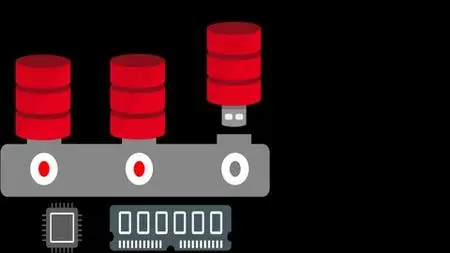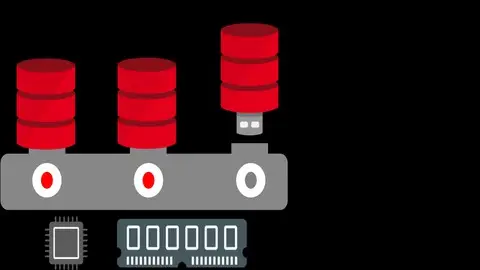Oracle Database Managing Multitenant Architecture
Last updated 4/2023
MP4 | Video: h264, 1280x720 | Audio: AAC, 44.1 KHz
Language: English | Size: 4.52 GB | Duration: 14h 28m
Last updated 4/2023
MP4 | Video: h264, 1280x720 | Audio: AAC, 44.1 KHz
Language: English | Size: 4.52 GB | Duration: 14h 28m
Oracle Multitenant Database
What you'll learn
Learn to manage Oracle Multitenant Database
Oracle Multitenant Architecture
Oracle Multitenant Database with deep learning
Oracle Database
Understand Oracle Database Multitenant Architecture
New Features 18c, 19c and 21c for Multitenant Architecutre
Requirements
RDBMS Knowledge
Oracle Database Admin
Description
This course is design for understand Oracle Database Multitenant ArchitectureWe will covers all aspects of the multitenant architecture and the components of an Oracle multitenant container database and its regular and application pluggable databases. You will learn why and how to create and manage a multitenant container database and its regular and application pluggable databases, with storage structures appropriate for the business applications. You practice cold and hot cloning, plugging unplugged pluggable databases in multitenant container databases using various methods.You will also learn how to create common and local users and administer database security to meet your business requirements by using encryption, Database Vault and auditing and you will learn how to create a database deployment in the Cloud.The multitenant architecture will help bussines to use multiple database in one instance. Multitenant Database consolidation is the process of consolidating data from multiple databases into one database on one computer. Starting in Oracle Database 12c, the Oracle Multitenant option enables you to consolidate data and code without altering existing schemas or applications.Starting in Oracle Database 21c, a multitenant container database is the only supported architecture. In previous releases, Oracle supported non-container databases (non-CDBs).CDBA CDB contains one or more user-created PDBs and application containers.At the physical level, a CDB is a set of files: control file, online redo log files, and data files. The database instance manages the files that make up the CDB.PDBsA PDB is a portable collection of schemas, schema objects, and nonschema objects that appears to an application as a separate database.At the physical level, each PDB has its own set of data files that store the data for the PDB. The CDB includes all the data files for the PDBs contained within it, and a set of system data files that store metadata for the CDB itself.
Overview
Section 1: Oracle Database Architecture and CDB PDB Basics
Lecture 1 Oracle Architecture Overview
Lecture 2 Oracle Architecture (Database Buffer Cache)
Lecture 3 Oracle Architecture (Redo Log Buffer)
Lecture 4 Oracle Architecture In Memory and Process
Lecture 5 Oracle Architecture (Background Process)
Lecture 6 Oracle Architecture (Storage Architecture)
Lecture 7 CDB and PDB Database
Lecture 8 Cloning a PDB Using DBCA in Silent Mode
Lecture 9 Duplicate CDB Using DBCA in Silent Mode
Lecture 10 Relocate PDB to Another CDB Using DBCA in Silent Mode
Lecture 11 Demo CDB and PDB 21c
Section 2: Introduction CDB Baiscs
Lecture 12 Adding a CDB in Enterprise Manager
Lecture 13 Named Credentials
Lecture 14 Oracle Enterprise Manager Express
Section 3: CDB and Regular PDBs
Lecture 15 Exploring CDB Architecture and Structures
Lecture 16 Creating a New CDB
Lecture 17 Creating a New PDB
Section 4: Application PDBs and Application Installation
Lecture 18 Installing an Application in an Application Container
Lecture 19 Upgrading an Application in an Application Container
Lecture 20 Querying Data Across Application PDBs in CDB
Section 5: CDB and PDB Management
Lecture 21 Starting up and Shutting down a CDB
Lecture 22 Opening and Closing PDBs
Lecture 23 Renaming a PDB
Lecture 24 Setting Parameter Values for PDBs
Lecture 25 Renaming PDB Services
Section 6: Storage
Lecture 26 Managing Tablespaces
Lecture 27 Managing UNDO Tablespaces
Section 7: Security
Lecture 28 Managing Common and Local Users, Privileges, and Roles
Lecture 29 Managing Common and Local Objects in Application Containers
Lecture 30 Enabling Common Users to View Information About PDB Objects
Lecture 31 Applying Recorded Statements in Application PDBs
Lecture 32 Managing PDB Lockdown Profiles
Section 8: Duplicate
Lecture 33 Duplicate CDB from on premises to Cloud
Lecture 34 Duplicate PDB from CDB
Section 9: Performance
Lecture 35 Performance CDB and PDB
Professional DBA,Database Administrator,Oracle DBA,DBA



